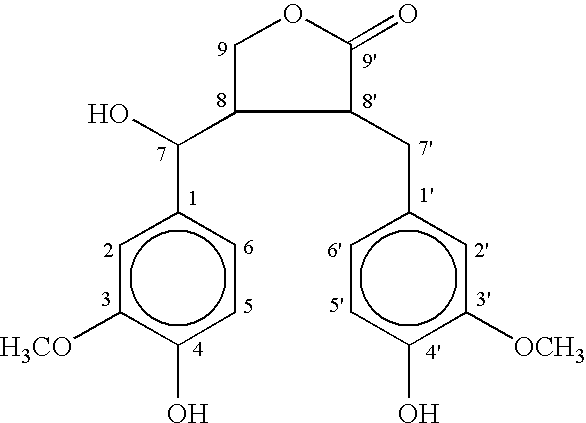Method for the production of a phenolic substance from wood
a phenolic substance and wood technology, applied in the field of wood phenolic substance production, can solve the problems of paper quality decline, no suitable process for large-scale recovery of hmr from wood,
- Summary
- Abstract
- Description
- Claims
- Application Information
AI Technical Summary
Problems solved by technology
Method used
Image
Examples
example 1
[0037]A batch reactor was charged with 200 kg of ground wood material (ground spruce wood derived from oversized chips) and 1200 l of ethanol was added. The mixture was heated to boiling and stirred 1.5–2.5 h. The mixture was cooled to about 55° C. and the ethanol solution was separated from the wood particles by filtration. The extraction of same wood material was repeated with 600 l of ethanol by using same process parameters. After the extraction was completed, the ethanol was separated from wood material, the two ethanol extracts were combined and finally concentrated by distillation.
example 2
[0038]According to the circulation method, the extraction was carried out as follows: A pressure filtration apparatus was charged with 65 kg of finely divided wood. About 600 kg of ethanol was charged into the reactor, heated to about 73° C. and the pre-heated ethanol was circulated through the pressure filter for about 12 h. The ethanol solution was transferred in to the storage tank and the extraction process of the same wood material was repeated under the same conditions with another 600 kg of ethanol. The two ethanol extracts were combined and concentrated by distillation.
Preparation of Potassium Acetate Adduct of Hydroxymatairesinol
example 3
[0039]Into the glass reactor 3100 g of hydroxymatairesinol-rich extract (loss on drying 60.6%) obtained in the extraction process described in Example 1, 1860 g of ethyl acetate, 290 g of ethanol; 62 g of acetic acid and 78 g of water were charged. The temperature was adjusted to 25° C. and 465 g of potassium acetate was added, mixture was seeded and agitated over night at 25° C. The product was filtered, washed with ethyl acetate and finally dried under vacuum at 50° C. The yield was 287 g (18.6% calculated from the amount of dry substance in the concentrate). The purity of product was 97 area %.
[0040]It will be appreciated that the methods of the present invention can be incorporated in the form of a variety of embodiments, only a few of which are disclosed herein. It will be apparent for the expert skilled in the field that other embodiments exist and do not depart from the spirit of the invention. Thus, the described embodiments are illustrative and should not be construed as re...
PUM
 Login to View More
Login to View More Abstract
Description
Claims
Application Information
 Login to View More
Login to View More - R&D Engineer
- R&D Manager
- IP Professional
- Industry Leading Data Capabilities
- Powerful AI technology
- Patent DNA Extraction
Browse by: Latest US Patents, China's latest patents, Technical Efficacy Thesaurus, Application Domain, Technology Topic, Popular Technical Reports.
© 2024 PatSnap. All rights reserved.Legal|Privacy policy|Modern Slavery Act Transparency Statement|Sitemap|About US| Contact US: help@patsnap.com








